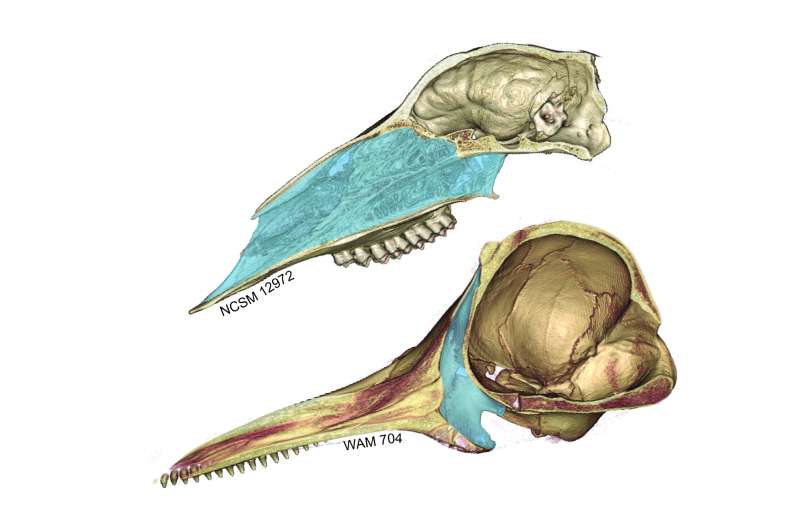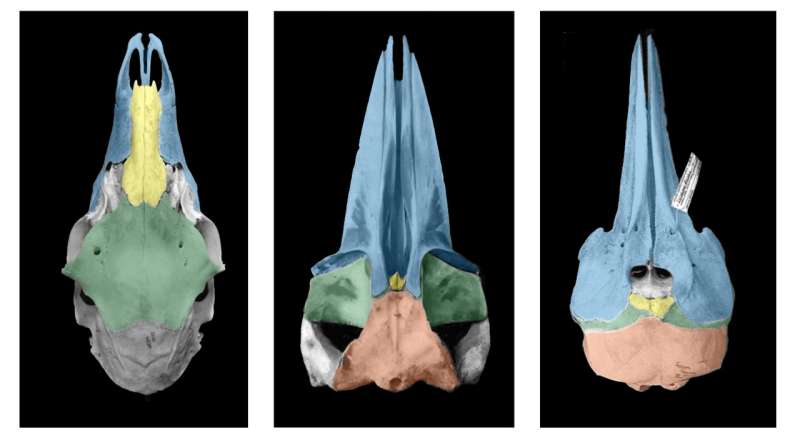3D digital reconstructions from CT scans showing bisected skulls of a white-tail deer (Odocoileus virginianus; top) and bottlenose dolphin (Tursiops truncatus; bottom) with the bony nasal passage highlighted in blue. The nasal passage is parallel to the snout in most terrestrial mammals (e.g., deer) whereas the nasal passage has become reoriented away from the hard palate in cetaceans. Credit: Rachel Roston.
The two major types of cetaceans appear to have evolved their characteristic blowholes through different anatomical transformations, according to a study being presented at the American Association for Anatomy annual meeting during the Experimental Biology (EB) 2021 meeting, held virtually April 27-30.
Cetaceans, a group of marine mammals that includes whales and dolphins, evolved from ancestors that walked on land around 50 million years ago. Somewhere along the way, the forward-pointing nose shifted to an upward-pointing blowhole, making it easier for the animals to breathe air while swimming.
For the new study, researchers observed shifts in nasal passage orientation in spotted dolphin and fin whale embryos and fetuses. Both species initially develop a forward-pointing nose, like any other mammal, which gradually transforms into a blowhole by birth. Anatomical changes during prenatal development can provide clues about how certain traits evolved over time.
"The main difference we observed is in how the nostrils reach this position during prenatal development—there does not seem to be one way to do it," said Rachel Roston, Ph.D., a postdoctoral fellow at the University of Washington and the study's lead author. "The dolphin species and other toothed whales showed backwards bending of the skull, whereas the fin whale and other baleen whales showed changes in the occipital bone at the back of the skull."
(left to right) Color-altered photographs showing skulls of a white-tail deer (Odocoileus virginianus), fin whale (Balaenoptera physalus) and pantropical spotted dolphin (Stenella attenuata) as viewed from the top. These skulls show the different positions of the nostrils in the three species, at the tip of the snout in the deer and toward the back of the snout and opening "up" in the cetaceans. Credit: Rachel Roston: deer, NCSM 14152; cetaceans modified from True (1904) and Palacios et al. (2014), respectively
Researchers have previously studied other differences in the nasal passages of the two types of cetaceans; for instance, toothed whales have a single nostril whereas baleen whales have two. By focusing on the part of the skull that connects the nasal passage and the rest of the body, the new study examines previously unexplored territory at the intersection of nasal passage orientation and head-body alignment.
Roston says the work suggests that the two cetacean types may have evolved their blowholes through different developmental processes, though additional research, such as studies of the fossil record, would be needed to more rigorously test this hypothesis.
"Few, if any, other mammals have evolved such an extreme shift in nasal passage orientation and nostril position," said Roston. "Understanding how developmental transformations lead to nasal passage reorientation during prenatal development helps us understand how changes to development can lead to the evolution of extreme and unique anatomical features."
More information: Roston will present this research in poster R4523 (abstract).
Provided by Experimental Biology

























